|
sito + "/AREA=" + sezione + "/AAMSZ=" + misura + "/ACC_RANDOM=" + bumber + "/PAGEID=" + pageid + "'>"); document.write(""); |
| home > allestimenti |
|
sito + "/AREA=" + sezione + "/AAMSZ=" + misura + "/ACC_RANDOM=" + bumber + "/PAGEID=" + pageid + "'>"); document.write(""); |
| home > allestimenti |
| FOA's
British Pavilion at the Venice Biennale Lucy Bullivant |
||||
| [in italiano] | "As
a complex organisation, an interesting building always has an interesting
epic, a story that is embedded in the organisation of matter", according
to Foreign Office Architects. Their Yokohama International Port Terminal,
a £135m project resulted from a spectacular international competition
win in 1995, beating 665 other entries. Completed in 2002 after eight
years it indeed represents an epic on many levels. |
[03jan2003] | ||
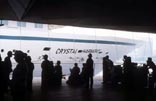 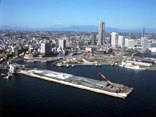
|
The
creative approach of Farshid Moussavi and Alejandro Zaera-Polo, the
directors of FOA, to the architectural design task of Yokohama and interpretation
of the brief epitomises a transformatory process in architecture. Of
all the practitioners of their generation, FOA possess the most intensely
focussed and highly innovative thesis about putting a specific set of
design principles into practice. |
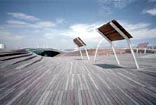 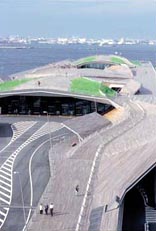 |
||
|
Architecture
is about telling stories. Not only does such an epic set a challenge
when it becomes the subject of an architectural exhibition -especially
one created by the architects themselves- but in order for it to be
understood more widely, it demands that the bigger themes emerging from
such an intense process be given closer scrutiny. FOA were given the
opportunity to make such an exhibition about Yokohama, and achieved
a highly acclaimed success on both fronts. They narrowly missed winning
the Biennale prize for best national pavilion to the Dutch. The judges'
choice of veteran architect Herman Hertzberger identified a sophisticated
solution, but one that didn't possess the same degree of imagination
and wider vision. Not only did the FOA show explore the multiple yet
consistent themes of their work, but it did it through exploiting to
the full the medium used. |
||||
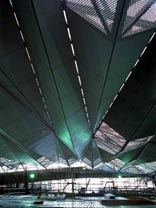 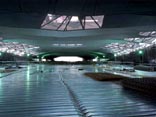 |
It
was early in 2002 that FOA won an invited competition to explore the
various aspects of Yokohama in the form of an exhibition in the British
Pavilion at the VIII Venice Architecture Biennale (8 September-3 November
2002), commissioned and organised by the British Council. |
|||
| Although
the overall Biennale directed by Deyan Sudjic was a digest, entitled
Next, of an international selection of soon to be completed buildings,
FOA decided not to fall in line with the rationale behind the display
in the Arsenale, presenting Yokohama conventionally with models, but
to ‘dissect' -as they put it- their recently completed building -at
the time of the opening of the Biennale in September 2002 little seen
by Westerners beyond architectural critics eager to do their reviews-
and open up a discussion about architecture through positing a series
of themes central to the making of Yokohama, and above guiding elements
of their work in general. It is this formation of a larger set of principles
that distinguishes FOA's intention for their exhibition from the Next
concept. |
 |
|||
| The
brief, to realise a site-specific installation, also gave FOA the opportunity
to transform the five room Pavilion space using any means they pleased.
They decided to create a darkened space with blue light, which, given
the sequence of existing rooms, then became labyrinthine in character.
Each one they dedicated to a different aspect of the project -Landscape,
Borderlessness, Growth, Complexity, Tools and Technology- at the same
time extrapolating from it. |
||||
| These
themes crystallise the chief areas of FOA's thesis of practice: the
idea of generating organisation from a circulation diagram; on a hybridisation
between a park and a building, a structure and a landscape, a "pure
enclosure with a topography", in which the building becomes a continuous
ground, the surface of which folds into itself. Such a determination
of the materials used to make the building allows FOA to make one that
is porous, without fixed boundaries between internal and external space.
In so redefining the bordered nature of a transportation building or
the linear quality of a pier structure into something with a multiple
route spatial performance, they court a blurring between form and formlessness,
questioning the very inert identity of matter through an identification
with the immaterial mobility and yet patterned nature of the sea. |
||||
That
spatial performance is at the same time multiple in function, an interpretation
of programme that is less pre-defined than architecture has tried to
be in the past. This governs FOA's approach to structure (which performs
several roles -walls, floor and columns- and is made from longitudinal
girders that stack up as ramps, so that the structure and circulation
system become part of a complex whole). As a result, the circulation
directly affects the spatial definition. Because FOA's commitment is
to an open-ended process of making ("growing") buildings, rather than
designing a predefined solution, instead of traditional wet site construction,
Yokohama was custom-built in a process more like shipbuilding, with
pre-fabricated steel sections made in workshops in Korea over in ships
and hoisted into position with cranes. It also allowed thinking concerning
aspects such as the continuous topography of the building to evolve.
The idea of asphalt and rubber was replaced by a wood deck with a geometry
of surface following the geometry of the structural system. This geometry
was reconfigured many times to allow for new information, and its determination
as a surface extended through the construction stage. Photo credits: Valerie Bennet. The primary means FOA used to give the exhibition substance was not formal, showing models, but the high impact technology of projection, sponsored by NEC UK, exploring its full technical and visual capabilities -specifically the degree of shift and "keystoning" required to recreate their vision of Yokohama. |
||||
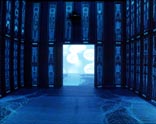 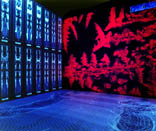 Photo credits: Valerie Bennet. |
 Photo credits: Valerie Bennet. Projections -using seven NEC projectors, four MT1050 models and three FT1150s with lenses- acted as an evocative design tool to demonstrate not just content (for instance, projected diagrams and photographs of Yokohama), but they work as immaterial actors in relation to the physical spaces, creating a dialogue in their interplay about the themes FOA chose. Yokohama as a project was above all about "how one can play and stretch the limits". The manipulable quality of the light beams working with the physical nature of the rooms created an appropriate, fluctuating set of spatial narrations. This way, FOA could "distinguish but also blend the separate rooms", creating "a kind of continuity of dark immersive spaces and walls that change", according to the nature of each projection specification. Such a concept suited the exploration of the growth of a building through its innumerable design stages. As a spatial experience the exhibition unfolded its identity -one that was not fixed as so many architecture exhibitions are, but in flux between states of being. |
|||
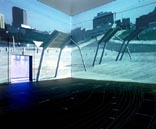
|
LANDSCAPE
is about the geological conditions that create natural spaces used by
humans in unlimited ways. Yokohama's artificial landscape results from
the principles of its vision and external conditions as a space with
a "limited flexibility". Here, three projectors operated on three walls,
synchronised, so that the "line of the horizon moves up and down as
if the sky is moving. This destabilises your view of the space", explain
FOA. BORDERLESSNESS refers simultaneously to the emerging, borderless condition of the world, the nomadic quality of the architects' activities and experience, and the historical symbolic point of entry of the site, when the country opened up to foreign ships in 1858. Angled projections were bled on the walls in this section. GROWTH is the chosen description of the evolution of the building, with its parallels with nature, in relation to FOA's original design principle and to subsequent information fed into its development. This is about how a space changes as it develops, and natural processes are important analogies for architecture to FOA, they used animations of plants and other natural and artificial growing entities which become objects: "the frame doesn't matter". COMPLEXITY is the resolution of principles and external pressures, which themselves result from both the brief, and the growth of the structure. The projection for this room therefore introduced an appropriate spatial metaphor: a figure, oval or round, that didn't relate to the surroundings, something that was difficult to achieve as a perfect fit. TOOLS AND TECHNOLOGY is the means by which the building can be designed and realised, essentially through customisation rather than standardised techniques, and personalised for individual needs. The projections included in this section show some tailored manufactured solutions for products FOA are aware of. Here the projections fit exactly. Lucy Bullivant |
|||
| Lucy Bullivant is an architectural critic, author and curator based in London. She writes regularly for the Financial Times, Tate magazine, Archis and Indesign. | ||||
| British
Pavilion at the 8th Venice Biennale |
||||
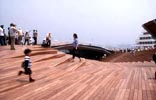 |
location: Giardini, Venice, Italy client: British Council architects: FOA brief: site specific installation in the British Pavilion on the work of FOA completion: July 2002 Yokohama International Port Terminal location: Yokohama, Japan client: Port Authority, City of Yokohama architects: FOA brief: 48.000 square meters of construction to handle 53.000 passengers a year to include: - 17.000 square meters of Domestic and International Cruise Terminal facilities including check-in, luggage handling, custom and immigration and related administration - 13.000 square meters of Citizens amenities including conference space, shops, restaurants and multi-purpose hall - 18.000 square meters of Traffic facilities including public parking, pick-up and drop-off traffic plaza and coaches parking completion: May 27th, 2002 |
|||
|
La
sezione Allestimenti laboratorio
|